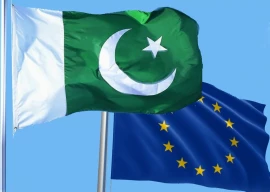Approximately 98,000 people are HIV positive in Pakistan, according to the World Health Organisation (WHO), with some reports putting the figure at over 100,000. The epidemic is spreading from a ‘concentrated’ one, where the disease is limited to a certain vulnerable group, to a ‘generalised’ one where more than one per cent of the population is HIV positive.
In Pakistan, as with most of Asia, the most vulnerable groups are injecting drug users (IDUs), transgender and female sex workers and as the global standards for measuring epidemics go, the disease is now spreading from these groups to the general public.
Talking to The Express Tribune Dr Quaid Saeed, head of the WHO Blood Safety and Hepatitis Programme, Pakistan is transitioning through a very crucial stage in the control of HIV epidemic where there is a window of opportunity that can be availed. The disease can be stopped from further spread in high risk groups by providing them efficient harm reduction services.
However, as the disease escalates in the country, the government’s strategies to counter it are falling victim to bureaucratic mismanagement. The National Aids Control Programme (NACP) has been unable to organize a lot of its activities due to severe paucity of funds. The programme, which runs on government funding, was broken down into provincial and federal units after the devolution of the Ministry of Health under the 18 Amendment in June 2011. Most functions of the NACP were passed on to the provinces but without proper planning causing bureaucratic confusion.

At the federal level, the programme is supposed to be the recipient for international funding, to prepare proposals for and liaise with international agencies for partnerships and importantly, provide technical and material resources to the provinces which could control the disease and conduct close surveillance. However, since the devolution no awareness campaigns or sessions have been organised by the federal NACP. The programme has also been unable to pay salaries to its 30 odd employees since June. On October 4, a store-keeper with the NACP Mohammad Razaq, tried to set himself on fire in protest. Razzaq, 43, who is diabetic, has been an employee of the NACP for 22 years.

Given this status of the main Aids fighting body, Pakistan’s ability to achieve the Millennium Development Goal to limit the spread of the disease by 2015 seems like a tall order.
The Planning and Development Division (P&D), responsible for disbursing government funds to the NACP, has been delaying the release of funds, as according to it the necessary paperwork is incomplete. International donors like the World Bank and Department for International Development (DFID) withdrew their support for the NACP in 2010 after the floods, in what is described as a major setback for the programme.
Dr Saeed said the services provided by the NACP for high risk groups have seen a marked reduction in the last few years because of diminishing resources, devolution of the health ministry and lack of capacity in the provinces. “It is time that we take control of this situation and give due attention to this impending threat to our nation before it is too late,” he said. Dr Saeed went on to state that because of NACP’s inability to manage the Aids programme efficiently there is a poor record keeping of those affected with Aids, their location and status.
Published in The Express Tribune, December 1st, 2012.
COMMENTS (8)
Comments are moderated and generally will be posted if they are on-topic and not abusive.
For more information, please see our Comments FAQ












1734899716-0/image-(15)1734899716-0-270x192.webp)










*keep in mind that the sort of work "sex workers" do has always been a contributing factor in the spread of aids, and the writer's sympathy towards such type of workers is a clearly conradicts his supposed resolve in eliminating aids. *
The article is full of faults beginning with the writer's approach is ridiculous of finding beuracratic ineffeciency as the principle force behind the impending threat of HIV, when no mass awareness campaign is in effect and combatting the spread of aids in our society does not seem to be on the main stream media's list of priorites.
The writer also seems fond of using the sympathetic term of "sex workers" for prostitutes which implies a great deal of acceptance for the 'work' they do.
The anti-aids campaign has proved to be diastrous because it is not established on a sound vision or a commendable action plan. The lack of a functional spiritual/ ethical code of life on which people should live is the prime factor in the spread of aids.
@GT Your obsession with Pakistan knows no bounds. I've never seen Pakistanis trolling on Indian domestic news as Indians do. And when Pakistanis do, Indians are so foul-mouthed and your websites allow ridiculous comments through.
@JOHN: yeah and even china with huge population...anything u r pointing at?? whats with the sick obsession........think of eradicating polio first............
@JOHN Your obsession with India knows no bounds. India had fewer HIV infections last year. India is getting a hold over number of people with HIV, Pakistan is not. Plus since you Pakistanis think AIDS is widespread in India, let me give you a small statistic. Around 0.1% is affected with HIV. You have to be ashamed, your comment not only looks degrading for people who have been affected by it, but also shows no concern to prevent the increase in numbers.
relax,India has more AIDS patients than us
Dear Editor, For the last 30 years the HIV victims number is the same same with a very minor difference, say one percent up or down.Is it not a joke with the people. And secondly none has been reported by the media as dead or recovered in this long period. How it is by the way and what kind of reporting it is ?
Mohammad Baig Pakistan Feature Syndicatestrong text*strong text*
strong textISLAMABAD: Approximately 98,000 people are HIV positive in Pakistan, according to the World Health Organisation (WHO), with some reports putting the figure at over 100,000. The epidemic is spreading from a ‘concentrated’ one, where the disease is limited to a certain vulnerable group, to a ‘generalised’ one where more than one per cent of the population is HIV positive. emphasized text